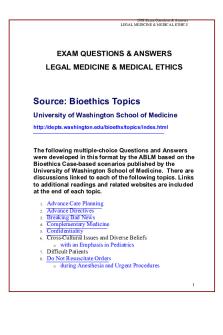Medical Sociology MTO1 Answers for exam questions listed PDF

| Title | Medical Sociology MTO1 Answers for exam questions listed |
|---|---|
| Author | Peter Tsai |
| Course | Medical Sociology |
| Institution | Szegedi Tudományegyetem |
| Pages | 10 |
| File Size | 172.7 KB |
| File Type | |
| Total Downloads | 46 |
| Total Views | 130 |
Summary
Medical Sociology MTO1 exam questions answer. For year 2 English general medicine course. Chapter 1 to 7....
Description
MedicalSociology2021/22Autumn Chap1 Q1
MTO1(Chap.1–7)
.
SOCIOLOGYINTHEMEDICALCURRICULUM.WHATFOR? Whatissociology?
Ans1 Obtainingobjectivescientificinformationaboutaproblemarisingonthesociety‐level. Q2 Whatissociologicalimagination? Ans2
To‘thinkourselvesaway’fromthefamiliarroutinesofourdailylivesinordertolookat
themfromanewpointofview. Q3 Introducethefoundersofsociology(A.Comte,E.Durkheim,K.Marx,M.Weber). Ans3
A.Comte:Frenchphilosopher,writer,andfounderoftheacademicdisciplineofsociology.
Hecreatedtheterm‘sociology’tonamethenewscienceofsociety. E.Durkheim:Functionalistsociology;Heformallyestablishedtheacademicdisciplineof sociology.“Socialfactsareallthoseinstitutionsandrulesofactionwhichconstrainor channelhumanbehavior” K.Marx:Conflicttheories;Heanalyzedthecapitalistsocietiesanddifferentsocialproblems andtherelationshipbetweeneconomyandtheworkerswithinthecapitalistsystem.In Marxismsystem,governmentsexisttoprotectthewealthybutnotthecommongood.He definedthesocialstructureaspowerful,butdeterminedconflictandinequalitybeingtypical inallsocieties.
Q4
M.Weber:Interactionalism;meaningfulcharacterofsociallifeandthesocialactionsof individuals. Definesociologyasascience.
Ans4 Sociologyisthescientificstudyofhumanlife,socialgroups,wholesocieties,andhuman worldassuch.Itssubjectmatterisourownbehaviorassocialbeingsinrelationshipswithmany otherpeople. Q5
Introducethemoderntheoreticalapproachesinsociology(functionalism,conflictperspective,
symbolicinteractionism). Ans5 Functionalism:originsfromE.Durkheim.focusesmoreonthemacro‐levelofthesocial structure.Thistheoryseesthesocietyasasystem,inwhichallmembers,institutions,and behaviorshaveimportantfunctions. Conflictperspective:conflicttheoryoriginsfromK.Marx.Societiesneedconflicts.Different groupsandinstitutionshavetheirowninterestsandtheyhavetofightwitheachotherfor moregoods. Symbolicinteractionism:MaxWeberestablished.Meaningfulcharacterofsociallifeand socialactionsofindividuals.Symbolisanimportantphenomenoninthesociety,focuseson Q6
face‐to‐faceandeverydayinteractions. Describethelevelsofasociologicalstudy.
Ans6
Macrosociologyisbasedontheanalysisoflarge‐scalesocialstructuresandlong‐term
processesofchange.Itdealswiththeinstitutionsthatinfluenceourdailylife.Microsociology concentratesonface‐to‐faceinteractionswithinasocialinstitution. Q7 Explainwhyitisimportanttostudysociology. Ans7
Awarenessofculturaldifferences,betterunderstanding,howothersliveandwhatkindof
problemstheyhave,andassessmentoftheeffectsofpoliticaldecisions.
1
MedicalSociology2021/22Autumn Chap2 Q1
MTO1(Chap.1–7)
Editor:Yu‐TingTsai,M.Sc.,P.T.,B.Sc.
WHERESOCIOLOGYANDMEDICINEMEET Whatismedicalsociology?
Ans1
Studyofhealthcareasitisinstitutionalizedinasociety,andofhealthorillness,andits
relationshiptosocialfactors. Q2 Introducethemajortopicsinmedicalsociology. Ans2 Relationshipbetweenthesocialenvironmentandhealthstatusandillnesses Socialepidemiology:analysesthetrendsandpatternswithinapopulationorindifferent populations. Socialstress:Imbalance,uneasinessoriginatingfromtheinabilityofdealingwithworkor family‐relatedstress. Healthandillnessbehavior Healthbehavior:individuals’behaviorforhealtheffect. Experienceofillnessanddisability:Howpeoplereact,iftheyarediagnosedwithanillnessor adisability. Healthcarepractitionersandtheirrelationshipwithpatients Physiciansandthemedicalprofession:roleofdoctorsinoursocietyandthe characterizationofmedicineasaprofession Medicaleducationandsocializationofphysicians:howstudentsbecomedoctors. Nurses,mid‐levelhealthcarepractitionersandalliedhealthworkers Alternativeandcomplementaryhealingpractices Physician‐patientrelationship Thehealthcaresystem Typeofhealthcaresysteminfluencethequalityoflife Healthcaredelivery:Organizationsbelongtothehealthcaresystem. Thesocialeffectsofhealthcaretechnology:useofnewtechnologiesinhealthcarehas socialandpublicpolicyconsequences. Comparativehealthcaresystems Q3 SummarizethemostimportantcharactersoftheBlackReport. Ans3 Firstreportontheassociationbetweensocialclassandmortality.Working‐classmenand womenaresignificantlymorelikelythanarethoseinthemanagerialorprofessionalclassestodie early. Q4 SummarizeDurkheim’sstudyaboutsuicide. Ans4
Linkbetweenthetypeofsocialintegrationandsuicide.Suicidecanhaveoriginsinsocial
causesratherthanjustbeingduetoindividualtemperament.Lowerrateofsuicideamong Catholicsandtheorizedthatthiswasduetostrongerformsofsocialcontrolandcohesionamong themthanamongProtestants.Suicidewaslesscommonamongwomenthanmen,morecommon amongsinglepeoplethanamongthosewhoareromanticallypartnered,andlesscommonamong thosewhohavechildren.Soldierscommitsuicidemoreoftenthanciviliansandthatcuriously, ratesofsuicidearehigherduringpeacetime.
2
MedicalSociology2021/22Autumn Chap3
MTO1(Chap.1–7)
.
HOWTOSTUDYTHESOCIETY?
Q1 Whatisscience? Ans1 Involvesthedisciplinedmarshallingofempiricaldata,combinedwiththeconstructionof theorieswhichilluminateorexplainthosedata. Q2 Whatkindofsociologicalquestionsare? Ans2 Factualquestionsifwewanttoknowsimplywhathappened. Comparativequestions:knowifthishasalsobeenthecaseinothercountries. Developmentalquestion:characterizesthepresentandthepast. Theoreticalquestions:Examinehowhuman‐madeconceptsinfluencehumanactions. (Money&Happiness) Q3
Introducethestepsoftheresearchprocess.
Ans3 Definingtheresearchproblem Reviewingtheevidence Formulatingahypothesis Selectingaresearchdesign Sampling Carryingouttheresearch Analysingdata Reportingthefindings Q4 Samplingmethods. Ans4 Non‐ProbabilitySamplingTechniques Easilyaccessiblesubjects Expertselection/JudgementalSampling Snowballmethod Quotasample ProbabilitySamplingTechniques Simplerandomsample Systematicsample Stratifiedsample Clustersample Q5 Qualitativeandquantitativemethods. Ans5 Quantitativemethodsmeasuresocialphenomenabymathematicalmodelsandstatistical analysis.Qualitativemethodsgatherdetailed,richdataallowingforanin‐depthunderstandingof individualactioninthecontextofsociallife Q6 Introducethemethodsofdatacollection(survey,interview,observation,ethnography,secondary dataanalysis,existingstatistics,contentanalysis,experiment) Ans6 Surveys Predesignedquestionsandusuallyprovidingthemanswerchoices. Asurveyisalwaysanalyzedbystatistics.
3
MedicalSociology2021/22Autumn
MTO1(Chap.1–7)
Editor:Yu‐TingTsai,M.Sc.,P.T.,B.Sc.
Interviews Askingpeoplequestionsthatareopen‐ended. Analyzedfortheirmeaningandthemes. Observation Watchingpeopleinordertodocumenttheirbehavior. Understandhowpeopleinteractwithoneother,andtofindpatterns. Ethnography Immersingyourselfinacultureorsubcultureinordertounderstandit. Cancombineformalandinformalinterviews,observationorsometimescontentanalysis. Secondarydataanalysis Existingstatistics Fromdatacollectionofgovernmentalagencies Contentanalysis Gatheringexistingtextsandcontents,andrevealnotonlytheobvious,butalsothesubtler messagesorideascontainedwithinthetextorimage. Experiment Zimbardo’sStanfordPrisonExperiment
4
MedicalSociology2021/22Autumn Chap4
MTO1(Chap.1–7)
.
BECOMINGADOCTOR
Q1 Definethetermsocialisation. Ans1 Interdisciplinaryandreferstoprocessoflearningsocialroles.Humaninfantgradually becomesaself‐aware,knowledgeableperson,skilledinthewaysofthecultureintowhichheor shewasborn. Q2 Introducetheagenciesofsocialisation. Ans2 Groupsorsocialcontextsinwhichsignificantsocialisationtakesplace.Themostimportant agenciesarefamily,school,peergroups,organisations,workplace,andmedia. Q3
Defineprimaryandsecondarysocialisation.
Ans3 Primarysocialisationisveryintensive;itoccurswhenachildlearnstheappropriate language,attitudes,values,andactionscharacteristicofaparticularculture.Secondary socialisationreferstotheprocessoflearningwhatisconsideredappropriatebehaviourfora memberofasmallergroupwithinthelargersociety. Q4 Definethetermgender. Ans4 Socialexpectationsaboutbehaviourregardedasappropriateforthemembersofeachsex, conventionallyasmasculineorfeminine. Q5
Introducegendersocialisation.
Ans5 Learningofgenderrolesviasocialagenciessuchasfamily,stateandmassmedia. Q6 Defineprofessionalsocialisation. Ans6
Medicalstudentsdeveloptheirprofessionalself,fusingitscharacteristicvalues,attitudes,
knowledge,andskillsintoamoreorlessconsistentsetofdispositionswhichgovernhis/her behaviourinawidevarietyofprofessionalsituations. Q7 Defineindirectprofessionalsocialisation. Ans7 Q8
Indirectimpactsbeyondformallecturesandpracticesthatformstudents’medicalidentity.
Definedirectprofessionalsocialisation.
Ans8 Formalcurriculum:subjects,credits,exams,duringwhichteachershandoverthestandards andframesoftheirprofessionalbehaviour. Q9
Definegenderhiddencurriculum.
Ans9
Femaleandmalestudentsanddoctorshavedifferentmedicalportrayals,anecdotes,media
iconsandpersonalexperiencewhichcertainlycontributetotheirperceptions.
5
MedicalSociology2021/22Autumn Chap5 Q1
Editor:Yu‐TingTsai,M.Sc.,P.T.,B.Sc.
DOCTORSASPROFESSIONALS Whatisaprofession?
Ans1 Q2
MTO1(Chap.1–7)
Occupationsthathavecertainspecialtraitsandcharacteristics.
Introducetheessentialtraitsofaprofession?
Ans2 Rigorousstandards Professionscarryspecialresponsibilities,mustundergoarigorousformalandinformal educationalandtrainingprocessandmustgocomplywithstringentpracticenorms. Significantautonomy Freedomfromlaycontrol.Professionitselfdeterminesandenforcesstandardsofeducation, licensure,andqualityofpractice. Considerableprestigeandidentificationwiththeprofession Accompaniedbyhighlevelsofincomeandprestige. Q3
Introduceprofessionalisation.
Ans3
Developmentofmodernprofessionsandtheprocessoftheirdifferentiation.Intensification
ofmarketprocesses,thedevelopmentofthemodernmanufacturingindustryandmechanization werethemostimportanttriggers.Roleofexpertiseandeducationbecamemoreimportant,and theexerciseofbirth‐basedpowerwasreplacedbythefreedomtochooseanoccupationandthe possibilityofaprofessionalcareerwithsocialandmaterialrecognition.Classicalprofessionswere thoseofdoctors,lawyers,teachers,andpriests. Q4 Introducedeprofessionalisation. Ans4
Processduringwhichdoctorsbecomemorelikeserviceprovidersratherthanphysicians.
Patientsaresimilartocostumersandleadstoareductioninphysiciandominance. Declineddominanceorautonomyofdoctors Competition. Consumerism Evidencebasedmedicine(EBM)orscience‐basedmedicine Controlstheautonomyofphysiciansindecision‐making. Q5 Characterisetheprocessoffeminisationinmedicine. Ans5 Asaconsequenceofdeprofessionalisationofmedicineandchangingtraditionalgender roles,moreandmorehighlyeducatedwomenenteredthemarket,wereemployed,manyof whomchosethemedicalprofession. Genderdifferencesareobviousalsoinmedicine. Womenarelesslikelytopursuecareer. Theroleofthedoctorhasslowlytransformedintoafemaleoccupationalrole.
6
MedicalSociology2021/22Autumn Chap6 Q1
MTO1(Chap.1–7)
.
DOCTORSANDPATIENTS Definitionandtypesofsocialrole.
Ans1
Roleisacomplexsetofstatus‐relatedbehavioursincludingstatus‐specificrights,
obligationsandnorms. Pervasiveroles Familyroles Professionalroles Temporaryroles Q2
Introducetheroletheory
Ans2 Theoreticalperspectiveinsociologyandsocialpsychologythatconsidersmostofthe everydayactivitiesassociallydefinedactions.Eachsocialrolehasaspecificsetofrightsand obligationsthattheroleholdermustcomplywith. Q3 IntroducetheParsonianmodelofthephysician‐patientinteraction. Ans3
PhysicianControl+
PhysicianControl‐
PatientControl+ PatientControl‐
Mutuality Paternalism
Consumerism Default
Mutualmodel:Idealformofinteraction. Consumeristmodel:Typicalinprivatecare. Paternalisticmodel:resemblestorelationshipbetweenfatherandchild. Defaultmodel:Mightoccurwhenthedoctorsuffersfromburn‐outsyndrome,whereasthe patientisnotabletopracticehighercontrol Asymmetricrelationshipwiththephysicianplayingthedominantrole. Q4 IntroducetheSzasz‐Hollandermodelofthephysician‐patientinteraction. Ans4 Threemodelsofpaternalism,determinedbythepatientsymptoms. Activity–PassivityModel:Beingtheexpert,thephysicianmakesthedecisionsintherelationship. Thepatientreliesontheexpertiseofthephysician;theyarelikeparentandchild.Thismodel appliestoshort,emergencysituations. Guidance–CooperationModel:Thephysicianislessautocratic,whilethepatientismore involvedintothetreatmentprocess.Thepatient’sconsenttodecisionsisdesired,butthe physicianretainsthedominantposition;theyarelikeparentandadolescent.Thismodelapplies tolong‐termsituations. MutualParticipationModel:Foraneffectivetreatmentprocess,thepatientmustfully participateandhavetoplayacentralroleinthetreatment.Thepatientknowsmoreabouthis orherowncondition,thanthephysiciandoes.Thismodelappliestochronicdiseases. Q5 Introducethebiomedicalandbiopsychosocialaspectsofmedicine. Ans5 Biomedicalapproachwasthedominanttherapeuticorientationandfocusesonlyonthe physiologicalaberrations,whichisdiseaseorientedratherthanpatientoriented.Biopsychosocial approachstatesthatpsychosocialfactorsarealsoneededtoprovideoptimalhealthcareand considerthepatientandthesocialcontext. Q6 Introducethebarriersofcommunicationduringtheprocessoftherapy. Ans6
7
MedicalSociology2021/22Autumn
MTO1(Chap.1–7)
Editor:Yu‐TingTsai,M.Sc.,P.T.,B.Sc.
Settingofthemedicalencounter Lengthofthemedicalencounter Mentalstateofthepatient Mismatchedexpectationsofphysicianandpatient Languagebarriers Communicationstyleofthephysician Q7
Whatisconflict?
Ans7
Manycomplementaryrolesbelongtoacertainsocialstatus,varyingaccordingtowhoma
personinteractswith.Whenthiscomplexityisshrinking,itmightleadtofallout(homeless)or consciouswithdrawalfromthesociety(hermit). Q8 Definetheroleconflict. Ans8
Situationinwhichapersonisexpectedtoplaytwoincompatibleroles.
Q9 Introducethedifferenttypesofroleconflict. Ans9 Intrapersonalconflict–Ittakesplacewithintheindividualwhendecidebetweenconflicting expectations. Intra‐roleconflict–Itmeanstheincompatibility,whichexistswithinasinglerole. Inter‐roleconflict–Itoccurswhentwoormorerolesareincompatiblewitheachother. Q10 Introducetheconflictsinmedicine. Ans10 Allocationof resources,Latentconflicts,Internet‐relatedconflicts, Family‐professionconflict. Q11 Whatiscompliance? Ans11 Patientsfollowtheinstructionsgivenofphysicians. Q12 Introducethefactorsrelatedtocompliance. Ans12 Sociodemographiccharacteristicsofpatients,Patient’sknowledgeaboutcondition,The severityofthedisease,ThecomplexityofthemedicalregimenandExtentofchangeinlifestyle demandedbytheillness. Q13 Whatisadherence? Ans13 Person’sbehaviorcorrespondswiththeagreedrecommendationsfromahealthcare provider.
8
MedicalSociology2021/22Autumn Chap7 Q1
MTO1(Chap.1–7)
.
HEALTHEXPERIENCE Introducetheconceptofhealth.
Ans1 Stateofcompletephysical,mentalandsocialwell‐beingandnotmerelytheabsenceof diseaseorinfirmity. Q2
Introducethebiomedicalfocusofhealth.
Ans2
Absenceorpresenceofdiseaseorphysiologicalmalfunction.Completelyobjective
phenomena,onlymedicalprofessionalscandefine,solelyaphysiologicalmalfunctionandhealth istheabsenceofdisease. Q3 Introducethesociological(sociocultural)definitionofhealth. Ans3 Affectednotonlybyphysiologicalaspectsbutpsychologicalandsocialfactors,aswell. healthistheoptimumcapacitytoperformsocialrolesandtasks Q4
IntroduceAlonzo’sfourdimensionsofhealthbehaviour.
Ans4 Prevention−tominimizetheriskofdiseasewithregularexerciseandhealthydiet Detection−todetectthediseasebeforeitssymptomsappear Promotion−toencourageandpersuadeindividualstoengageinhealth‐protectivebehaviors Protection−tomaketheenvironmentashealthyaspossible Q5
Whatisillnessbehaviour?
Ans5 Howcertainsymptomsmightbeperceived,evaluatedandacted(ornot)uponbypeople, whoexperiencedifferentsignsoforganicmalfunction. Q6
IntroduceZola’s‘socialtriggers.’
Ans6 Patient’sinterpretationofsymptomsdependonwhethertheyareperceivedas‘normal'or 'abnormal’ Perceivedinterferencewithvocationalorphysicalactivity Perceivedinterferencewithsocialorpersonalrelations Theoccurrenceofaninterpersonalcrisis Akindoftemporalizingofsymptomatology Sanctioning Q7
Introducethestagesofillnessexperience.
Ans7 Symptomexperience–somethingiswrong(self‐treatmentortryingtoignore) Assumptionofsickrole–takingonthesickrole(tryingtogetbetter) Contactmedicalcare–seekingillnesslegitimation(perhapsstillindenial) Dependentpatientrole–agreeingmedicaltherapy(mightnotfollowthemedicaladvice) Recoveryandrehabilitation–l...
Similar Free PDFs

Medical Law Exam Questions
- 2 Pages

Medical ethics questions and answers
- 67 Pages

EXAM, questions and answers
- 130 Pages

Exam, questions and answers
- 5 Pages

Exam, questions and answers
- 142 Pages

Exam, questions and answers
- 231 Pages

Exam, questions and answers
- 2 Pages

Exam, questions and answers
- 67 Pages

Exam, questions and answers
- 22 Pages

Exam, questions and answers
- 8 Pages

Exam, questions and answers
- 10 Pages

Sample Exam Questions Answers
- 11 Pages
Popular Institutions
- Tinajero National High School - Annex
- Politeknik Caltex Riau
- Yokohama City University
- SGT University
- University of Al-Qadisiyah
- Divine Word College of Vigan
- Techniek College Rotterdam
- Universidade de Santiago
- Universiti Teknologi MARA Cawangan Johor Kampus Pasir Gudang
- Poltekkes Kemenkes Yogyakarta
- Baguio City National High School
- Colegio san marcos
- preparatoria uno
- Centro de Bachillerato Tecnológico Industrial y de Servicios No. 107
- Dalian Maritime University
- Quang Trung Secondary School
- Colegio Tecnológico en Informática
- Corporación Regional de Educación Superior
- Grupo CEDVA
- Dar Al Uloom University
- Centro de Estudios Preuniversitarios de la Universidad Nacional de Ingeniería
- 上智大学
- Aakash International School, Nuna Majara
- San Felipe Neri Catholic School
- Kang Chiao International School - New Taipei City
- Misamis Occidental National High School
- Institución Educativa Escuela Normal Juan Ladrilleros
- Kolehiyo ng Pantukan
- Batanes State College
- Instituto Continental
- Sekolah Menengah Kejuruan Kesehatan Kaltara (Tarakan)
- Colegio de La Inmaculada Concepcion - Cebu



